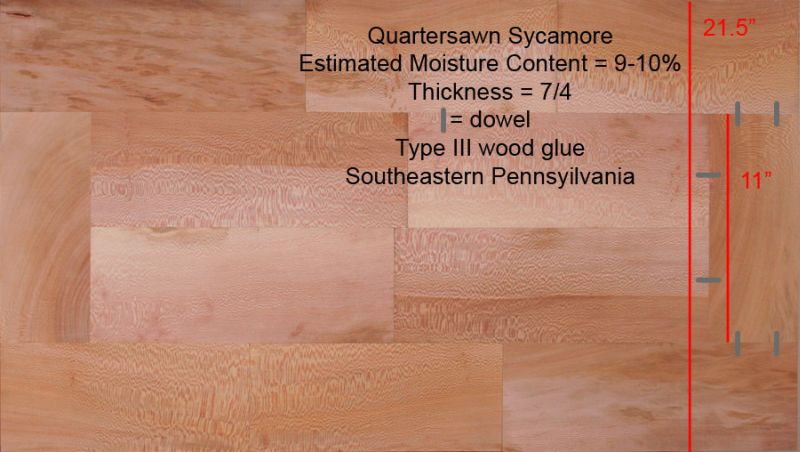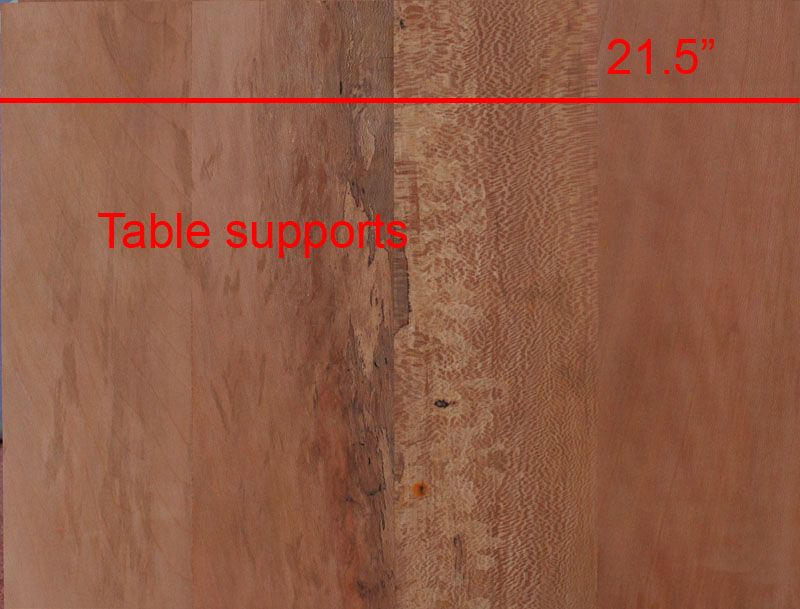Question
In a recent project I made a poor choice of wood placement by gluing two pieces of wood perpendicular to the rest of the table. I now realize the error of my ways. The wood in this case is (mostly) quarter-sawed American sycamore. I cut it and dried it myself for a year and then stored it on site to acclimate the wood to its environment for most of the fall while I worked on it. It is 7/4 thick. The perpendicular piece is 11" long so there is 11" of wood that will want to move and won't be able to. It is glued and doweled so I don't think it's going anywhere until it cracks (if it does). By using temperature and relative humidity I estimate that the wood fluctuates between 9 and 10% moisture content during the current winter season (southeastern PA).
If I have to I am willing to make a cut down the middle of the two poorly placed pieces to release pressure, but don't want to if it isn't necessary. I will be gluing and doweling the table top to solid wood legs/supports. Is 11" a small enough piece to survive or will it bust the table over time?

Forum Responses
(Furniture Making Forum)
From contributor H:
I don't think a year of air drying is near enough to stabilize 7/4 anything. If those solid wood legs are connected to a skirt, you do not need to dowel or glue the top to them. Screws in slotted holes or figure 8 fasteners will allow the wood to move and thus not crack or destroy your lags and skirt.
As a rule of thumb, an inch per year of thickness for air dried, and that should be indoors. It is near impossible to get air dried wood down to 9-10%. I am in northeast PA and weather here varies little from where you are.
Also, as contributor H has already said, doweling and gluing the legs to the top is a bad idea if the leg assembly is going to include a skirt or stretchers perpendicular to the length of the top. Doing so will only wreak more havoc.
1) Rout out the cross-pieces and replace them, or
2) Make two rip cuts along the glue joints that abut the end pieces, knock out those pieces and replace.
I also agree your wood hasn't dried long enough, but since you are this far, here is what I'd advise. I hope this is a personal piece and not a paying job. Use it as a learning experience and watch what happens to your top if you leave it alone. Or crosscut off the entire width of those two pieces. Then you can attach full width breadboard ends the right way.
As far as the table goes, I like the breadboard option and am going to cut off the end and reattach it using the breadboard technique. The table doesn't have a skirt and the legs are the same width as the table with the grain moving in the same direction. As far as my understanding goes, this should move at the same rate as the table and in the same direction, so it should be okay to dowel and glue? There is more face grain in the legs, though, than in the mostly quarter-sawed top.
I will buy the Hoadley - Understanding Wood book. Thank you for the suggestion. I enjoy learning new things and it looks like this book contains quite a bit of information.
If anyone notices something else that I did wrong, feel free to tell me. Thanks again for everyone's input and suggestions. This helped me make an informed decision.

In addition to the brackets, I am considering a double rabbet joint without any glue. Since the legs use more face-cut wood than the quarter-sawed table top, I want to allow for any difference in movement that could occur. Also, this may help if the wood is not completely dry, as was asserted in the beginning.